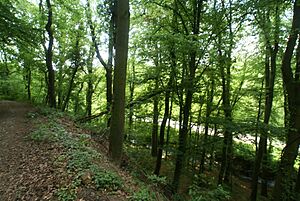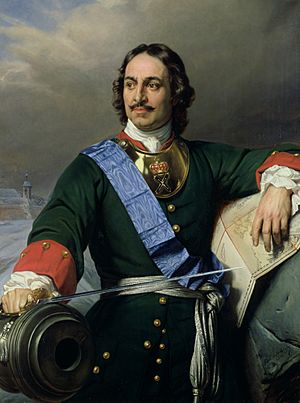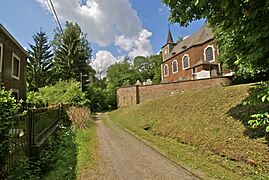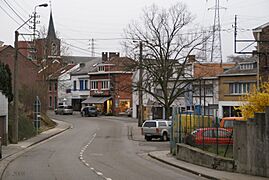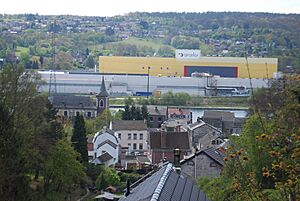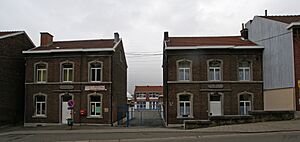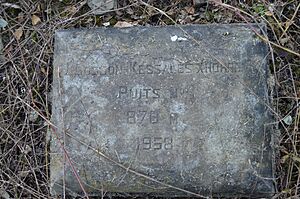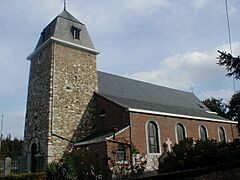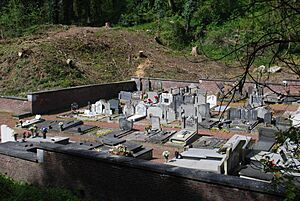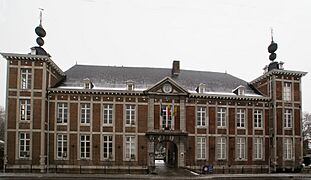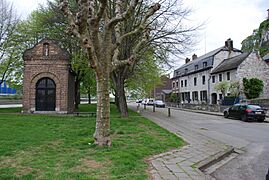Flémalle facts for kids
Quick facts for kids
Flémalle
Flémåle (Walloon)
|
|
|---|---|
| Country | Belgium |
| Community | French Community |
| Region | Wallonia |
| Province | Liège |
| Arrondissement | Liège |
| Area | |
| • Total | 36.68 km2 (14.16 sq mi) |
| Population
(2018-01-01)Lua error in Module:Wd at line 1575: attempt to index field 'wikibase' (a nil value).
|
|
| • Total | Lua error in Module:Wd at line 1,575: attempt to index field 'wikibase' (a nil value). |
| Postal codes |
4400
|
| Area codes | 04 |
| Website | www.flemalle.be |
Flémalle is a town in Wallonia, a region in Belgium. It is located in the Liège Province.
As of 2024, about 27,000 people live here. Flémalle is part of the larger Liège metropolitan area, which has over 380,000 residents. Its location is special, mixing nature like valleys and countryside with busy urban areas. This means you can find quiet natural spots and lively town centers.
Because it's close to big cities like Seraing, major highways, the Meuse River, and Liège Airport, Flémalle is growing. The town is building new areas, like Flémalle-Neuve, to welcome more people.
Historically, Flémalle is famous for early studies in paleontology (the study of ancient life) and Prehistory. A Roman document was found here. During the Middle Ages, the town was important for trade, especially in the village of Chokier. Even famous people like Peter the Great, a tsar from Russia, visited. Flémalle also played a key role in defending Liège during both World Wars, thanks to its fort.
André Cools was a very important political figure from Flémalle. He held many high positions, including Minister and President of the Socialist Party, before his death in 1991.
Sports are also a big deal in Flémalle. The town has hosted two kickboxing world championships. In handball, the ROC Flémalle club is one of the best in Belgium, with many national titles and cups.
Contents
What's in a Name?
The name Flémalle, like other nearby towns, ends with "-malle." This comes from the Walloon version of the Dutch word "-maal." This ending is common in the Hesbaye region.
The town's name first appeared in writing in 1086 as Fleimala. Even earlier, in 634, it was called Flédismamalacha.
A Look Back in Time
Ancient History
We know a lot about the ancient history of Flémalle thanks to Dr. Philippe-Charles Schmerling. He was a professor from the University of Liège. He explored several caves in the Liège area, including the Schmerling Caves.
These caves are famous worldwide. They are where the first fossil bone of a Neanderthal was found. This bone is known as Engis 2. Dr. Schmerling also found the second fossil of Homo sapiens in these caves. At that time, other Homo sapiens bones had only been found in Wales. The site is now protected as an important heritage site in Wallonia.
Another important cave in the area is the Ramioul Cave, discovered in 1911. Digs there have found remains from different periods, from 70,000 BC (when Neanderthals lived) to 2300 BC. This cave is part of the Préhistomuseum, one of Europe's largest museums about Prehistory.
Roman Times
When Julius Caesar conquered Gaul between 57 and 50 BCE, the people of Flémalle became part of the Roman Empire. This brought Roman knowledge, customs, and traditions to Belgium.
An old stone altar found here tells us that people used to worship a god named Mosea.
The Roman Diploma
An important old document, called the Flémalle Roman diploma, was found in the Meuse River in 1880. It dates back to the year 98 AD, during the time of Emperor Trajan. This diploma was given to a soldier. It allowed him to go back to his village.
The Middle Ages
After the Western Roman Empire ended, the Franks took over Roman lands. Flémalle became part of the Prince-Bishopric of Liège. This was a powerful area ruled by a Prince-Bishop.
The Awirs stream brought wealth to the area. There were mills and mines for zinc and lead. These mines were used until the 15th century. There was also a Cistercian monastery in Awirs.
In Chokier, people believe there were lime kilns (ovens for making lime). This is mentioned in a document from 1086. Mining for coal and stone also started in the 14th and 15th centuries. The last coal mine in Flémalle closed in 1955.
Local Lords
The Prince-Bishopric was divided into areas called districts. Flémalle was in the Hesbaye district. This district had several counties, including Hozémont. Awirs, Gleixhe, Chokier, and the two Flémalles (Grand and Small) were part of Hozémont.
Flémalle was split into several seigneuries (areas ruled by a lord):
- Flémalle-Haute: This area belonged to the Chapter of Saint Peter. In 1173, it was given to the Knights Templar.
- Awirs: In the 12th century, the Awirs and Aigremont areas were joined. They were ruled by a vassal of the Bishop of Liège.
- Gleixhe: This area was once called Awirs-Notre-Dame. It was named after a church that honored the Virgin Mary.
- Chokier: This area was first held by the Hozémont family.
- Ivoz: This is part of Ivoz-Ramet. It belonged to the Saint-Lambert Cathedral.
- Ramet: Also part of Ivoz-Ramet. Several people in the 12th and 13th centuries were named Ramet, showing its importance.
- Ramioul: This area belonged to the Duke of Lower Lorraine.
- Mons: This area, like Souxhon, Ruy, and the two Crotteux, was part of Mons-lez-Liège.
The Awans and Waroux War
This war started in 1297 and lasted 38 years. It greatly affected the Hesbaye region. The Prince-Bishop of Liège could not stop it.
The war was between two groups of lords: the Awans and the Waroux. They were actually from the same family! The war started when a young maid, Adoule, was taken by a Waroux knight. She was supposed to marry an Awans cousin. This war destroyed many castles and changed the power balance in the region.
Modern Times
In the 16th century, a small chapel in Chokier became a parish church. In the 17th century, a farm with vineyards appeared at Chokier Castle. The village also started making alum.
In 1717, Tsar Peter I visited Chokier. The mayor welcomed him with celebrations.
Alum mining was also important in Flémalle-Haute and Flémalle-Grande from the 16th to the 18th century. The Saint-Pierre chapter started quarrying stone in the 15th century.
Recent History
The last alum mine in Awirs closed in 1816. Coal mining then started, bringing a busy industrial period. The last coal mine in Awirs closed in 1928, and the last one in Flémalle closed in 1955.
In 1938, the Ivoz-Ramet bridge was opened. It was blown up in 1940 to slow down the Wehrmacht (German army) during World War II. It was rebuilt during the war.
During World War II, Flémalle was bombed, just like Liège. A tunnel in Flémalle was used as a safe place for people.
World War I
August 1914 saw the German Army invade Belgium. Liège and its area were the first to be affected. Despite strong forts like the Fort of Flémalle, the defenses were overcome. Many people fled towards the Netherlands, which was not involved in the war.
The Atlas V, an armored tugboat, left Liège on January 3, 1917, with 107 people. They were trying to escape to the Netherlands. Two of the crew and one passenger were from Flémalle.
The Water Crossing Accident
On January 23, 1918, a ferry carrying workers across the Meuse River had an accident. The ferry was designed for 60 people, but 80 rushed onto it. During the second trip, a hook broke, causing the boat to flip over. Out of 37 passengers, only 4 survived.
The 1930 Meuse Valley Fog
This event was one of the worst air pollution disasters in Europe at the time. It caused over 60 deaths and about 300 injuries. It happened in Engis, a town next to Flémalle.
From December 1 to 5, 1930, a thick fog stayed in the Meuse valley. The valley's shape, with high plateaus on either side, trapped the cold air. Factory chimneys, which were not very tall, released pollution that couldn't escape. This created a dangerous mix, similar to the Great Smog of London in 1952.
When the fog cleared, many people had severe breathing problems. There was also a heavy impact on livestock. Of the 60 deaths, 20 were in the Flémalle area. After 1930, steps were taken to prevent such accidents, with air monitoring stations installed in 1968.
Railway Accident of 1946
On December 1, 1946, a rock face collapsed near Chokier Castle. It fell onto the railway tracks below. Luckily, no one was hurt. A train with 400 workers had passed just two minutes before. The accident blocked the railway for over a month.
Aviation Accident of 1989
In December 1989, a pilot named Pieter Demuynck was flying a Mirage jet. The plane had a problem. The pilot kept it flying to avoid crashing into homes in Awirs. He ejected but did not survive. However, he saved many lives by guiding the plane away from residential areas. A commemorative plaque marks the spot where he died.
Where is Flémalle?
Sections of Flémalle
Flémalle is made up of eight main parts: Awirs, Chokier, Flémalle-Grande, Flémalle-Haute, Gleixhe, Ivoz-Ramet, Les Cahottes, and Mons-lez-Liège. Flémalle-Haute is the most populated, while Gleixhe has the fewest residents.
Small Towns and Villages
There are about 90 smaller towns and villages within Flémalle.
- Some localities in Flémalle
Les Trixhes
The Trixhes area was designed as a "garden city" in the 1930s. It was meant to connect the town to the countryside. Construction began in the 1950s, creating over 1,300 homes. This neighborhood features modernist buildings, lots of green spaces, and special pedestrian walkways.
Some parts of Les Trixhes had problems with humidity and were later torn down. Today, you can still see parts of the old roads and pathways. The area has sports centers, cultural centers, and a unique pedestrian network with tunnels under the main road.
Chokier
The Chokier area has a very rich history. Its castle, built on a rocky hill, dates back to the 9th century. In the 18th century, the castle was changed into the beautiful building you see today.
Chokier was well-known in the 11th century for its viticulture (grape growing), breweries, and inns. From the 16th to 19th centuries, it grew industrially with alum works, lime kilns, and factories.
Les Cahottes
Les Cahottes is a smaller, wealthier village. However, it has lost almost half its population due to development projects.
Flémalle's Location

Flémalle is in eastern Belgium, west of Liège. It's on a key route along the Meuse River, connecting France and Germany. To the north, you'll find the European route E42 highway and Liège Airport, a major cargo airport in Europe. Flémalle acts as a link between the Meuse valley, the Hesbaye region to the north, and the Condroz region to the south.
It's about 10 km from Liège, 43 km from Namur, and 81.5 km from Brussels, the capital of Belgium. It's also close to the Netherlands, Germany, Luxembourg, and France.
Nearby Towns
| North: Grâce-Hollogne | ||
| West: Saint-Georges-sur-Meuse |  |
East: Seraing |
| Southwest: Engis | South: Neupré | ⠀⠀⠀⠀⠀⠀⠀ |
Land and Rivers
Flémalle is shaped by the Midi Fault, a geological line that caused the 1983 Liège earthquake. This fault creates cliffs and hills. The town's altitude ranges from 62 meters along the Meuse River to 238 meters in the south. The Chokier Castle sits high on a hill because of this fault.

Flémalle is part of the Lower Meuse river system. The Meuse River flows through the town for over 7.6 kilometers. There are also seven smaller streams. About 4% of the land is a flood zone, with some areas at high risk.
The water table (underground water level) has been rising since the winter of 1977-1978. This is due to the end of coal mining in the Liège province.
Islands in the Meuse
Before the construction of quays in 1937, many islands were in the Meuse River here. This area was known as the "Chokier bottleneck," making river travel difficult. Old items like swords and coins were found when the river was developed.
Weather in Flémalle
Flémalle has a mild climate. The average temperature is 10.2 °C. During snowy periods, snow often falls on the higher parts of the town but not always in the warmer center along the Meuse.
April is usually the driest month, and December is the wettest. July is the warmest month, and January is the coldest. It rains about 10 days a month, which is a bit more than in Liège.
| Climate data for Flémalle | |||||||||||||
|---|---|---|---|---|---|---|---|---|---|---|---|---|---|
| Month | Jan | Feb | Mar | Apr | May | Jun | Jul | Aug | Sep | Oct | Nov | Dec | Year |
| Mean daily maximum °C (°F) | 4.9 (40.8) |
5.9 (42.6) |
9.7 (49.5) |
13.8 (56.8) |
17.3 (63.1) |
20.4 (68.7) |
22.2 (72.0) |
21.7 (71.1) |
18.6 (65.5) |
14.3 (57.7) |
9.1 (48.4) |
5.7 (42.3) |
13.6 (56.5) |
| Daily mean °C (°F) | 2.6 (36.7) |
2.9 (37.2) |
5.8 (42.4) |
9.4 (48.9) |
13.2 (55.8) |
16.3 (61.3) |
18.1 (64.6) |
17.7 (63.9) |
14.7 (58.5) |
11.1 (52.0) |
6.7 (44.1) |
3.5 (38.3) |
10.2 (50.3) |
| Mean daily minimum °C (°F) | 0.4 (32.7) |
0.2 (32.4) |
2 (36) |
4.8 (40.6) |
8.7 (47.7) |
11.6 (52.9) |
13.8 (56.8) |
13.5 (56.3) |
11 (52) |
8.2 (46.8) |
4.4 (39.9) |
1.4 (34.5) |
6.7 (44.0) |
| Average precipitation mm (inches) | 87 (3.4) |
77 (3.0) |
78 (3.1) |
65 (2.6) |
72 (2.8) |
83 (3.3) |
84 (3.3) |
87 (3.4) |
72 (2.8) |
71 (2.8) |
82 (3.2) |
99 (3.9) |
957 (37.6) |
| Average relative humidity (%) | 85 | 83 | 78 | 72 | 72 | 72 | 72 | 74 | 77 | 81 | 87 | 86 | 78 |
Town Planning
How Flémalle is Built
Flémalle's center is part of the continuous urban area of Liège. Most of the town is built up, except for areas like Awirs and Gleixhe. Many of Flémalle's important buildings, like the post office and town hall, are in the center. The police station is near National Road 677.
Before 1977, Flémalle's sections were separate towns. Now, services like libraries are more centralized. Old town hall buildings still exist. The Chokier area is known for its history and architecture. Awirs also has a distinctive castle.
Land Use
| Land Use Type | Flémalle | Province | Wallonia |
|---|---|---|---|
| Share of artificial land area | 27.7% | 12.9% | 10.7% |
| Share of residential land | 18.6% | 7.6% | 6.5% |
| Share of land occupied by commerce, offices, and services | 0.7% | 0.3% | 0.3% |
| Share of land occupied by public services and community facilities | 1.9% | 1.6% | 1.1% |
| Share of land for recreational use and urban green spaces | 0.4% | 0.6% | 0.6% |
| Share of land occupied by agricultural buildings | 0.4% | 0.8% | 0.6% |
| Share of land for industrial and artisanal use | 4.1% | 1.4% | 1% |
| Share of quarries, landfills, and abandoned spaces | 0.3% | 0.2% | 0.2% |
| Share of transport infrastructure | 1% | 0.5% | 0.4% |
| Share of other artificial spaces | 0.1% | 0.1% | 0% |
| Share of arable land and permanent crops | 20.7% | 22.2% | 28.5% |
| Share of grasslands and fallow agricultural land | 19.8% | 27.2% | 23.2% |
| Share of forests | 15.4% | 28.4% | 29.3% |
| Share of semi-natural environments | 5.6% | 2.4% | 2.5% |
| Share of wetlands | 0% | 1.1% | 0.3% |
| Share of water surfaces | 0% | 0.2% | 0.2% |
| Share of land of unknown nature (including uncategorized land) | 10.7% | 5.7% | 5.2% |
| Source: Iweps - WalStat (The portal for local statistical information in Wallonia) | |||
Flémalle is a very urbanized town. Its artificial land area and residential land are almost three times higher than the average for Wallonia. There are many large stores like Delhaize and Lidl, and two shopping centers.
The industrial area is four times larger than the average. This is because of two large ArcelorMittal sites and three major industrial parks. Even with all this development, agriculture still covers a good part of the land. However, there are fewer forests compared to the Walloon average.
Homes in Flémalle
| Year of Construction | Flémalle | Province | Wallonia |
|---|---|---|---|
| Share of buildings constructed before 1900 | 21.9% | 23.4% | 27.7% |
| Share of buildings constructed between 1901 and 1918 | 10% | 9.8% | 9.7% |
| Share of buildings constructed between 1919 and 1945 | 11.9% | 12.2% | 11% |
| Share of buildings constructed after 1945 | 56.2% | 54.6% | 51.6% |
| Source: Iweps - WalStat (The local statistical information portal for Wallonia) | |||
Flémalle has a high number of buildings built between 1946 and 1961. This was a time of much construction after World War II. This trend continued into the 1960s.
Many homes in Flémalle are terraced houses. These were often built for workers during the industrial revolution and the time of coal mining. In 2001, Flémalle had over 10,700 homes for its 25,777 residents.
Architecture
Liège architecture often uses the Romanesque and Mosane style. The Château d'Aigremont is a good example, mixing Louis XIV style with red bricks.
The Chokier area has well-preserved old buildings. The Trixhes neighborhood shows a newer, modernist style from the 20th century.
Future Plans
Flémalle has big plans for the future, called Flémalle 2030. These projects aim to improve the town:
- Grand'Route Renovation: This includes two projects. Flémalle-Centre will update the town park and create new public spaces. It will also add more parking. Flémalle-Grande will improve S. Donnay square and the "Flémalle Shopping" center.
- Flémalle-Neuve: This project will build 238 new homes, a new school, and offices. It will also have a new railway station and a footbridge over the Meuse River. This project is estimated to cost around 72 million euros.
- Modernizing Les Trixhes: This project will update the entire Les Trixhes area. It will improve roads, pedestrian areas, and add more shops and cultural spaces. New housing units are also planned.
- Eco-neighborhood of Mons-lez-Liège: This project will redevelop Place Mottard. It will add shops and homes, focusing on sustainable living and transport.
- Sustainable Urban Development: Flémalle wants to use sustainable methods in its town planning. This includes creating eco-districts and promoting green spaces.
There was also a project to remove ashes from a site. Asbestos was found, but tests showed it was in low amounts and not a risk. The asbestos is being safely removed.
Getting Around Flémalle
Flémalle is close to Liège and Seraing, making it a busy transport hub. The European route E42 highway is to the north, the Meuse River and its quays are in the center, and a national road is to the south.
Roads
Flémalle's main roads run from west to east. Some roads connect the Meuse River to the north, and one goes south. The rest of the roads connect to local urban and economic areas. The eastern part of town has more roads due to its closeness to Seraing.
The Walloon Motorway forms a border with Grâce-Hollogne. National Route 677 connects the town to the motorway. This road also serves Mons-lez-Liège, Les Cahottes, Les Trixhes, and the center of Flémalle.

National Route 90 runs along the right bank of the Meuse, connecting Huy to Liège. National Route 617 connects Engis to Jemeppe-sur-Meuse.
| Category | Municipal Territory | Wallonia | |
|---|---|---|---|
| Length (km) | Density (km/km2) | Density (km/km2) | |
| Motorways | 2.5 | 0.07 | 0.05 |
| Regional Roads | 25.6 | 0.70 | 0.45 |
| Municipal Roads | 251.2 | 6.85 | 2.86 |
| Total | 279.3 | 7.61 | 3.36 |
A large steel sculpture called "Le Cœur" (The Heart) is located at exit 4 of the E42 highway. It was created by artist Robin Vokaer.
Bridges
Only two bridges cross the Meuse River in Flémalle: the Ivoz-Ramet dam bridge and a railway bridge. A new footbridge is planned for the Flémalle-Neuve area. The Engis bridge is also nearby.

The Ivoz-Ramet dam bridge was built between the 1960s and 1980s. It has locks and a hydroelectric power station. It's a very busy waterway.
The railway bridge carries both freight trains and passenger trains. It connects to the Tubemeuse site and stations like Flémalle-Haute.
An old stone bridge, the Val Saint-Lambert bridge, was built in 1846 but was later destroyed.
Trains
Flémalle is at the meeting point of two railway lines: Namur to Liège, and Liège to Flémalle. Flémalle-Haute is the only station on the Liège-Flémalle line. The Namur-Liège line has three Flémalle stations. In 2006, over 1,500 passengers used these stations daily.

Flémalle-Haute station is unique in Belgium for its architectural style. It opened in 1850. The Leman station is named after General Leman, a hero from World War I. Flémalle-Grande station is near a shopping center.
A new station is planned for the Flémalle-Neuve project. All these stations offer quick access to the major Guillemins station in Liège.
Flémalle has two level crossings. The one in Chokier is known for being dangerous, with several accidents in the past ten years. There are plans to remove it, but the town is against it because it would cut off part of the village.
| Category | Municipal Territory | Wallonia | |
|---|---|---|---|
| Length (km) | Density (km/km²) | Density (km/km²) | |
| Conventional Lines | 5.7 | 0.15 | 0.08 |
| Freight Lines | 8.5 | 0.23 | 0.02 |
| High-Speed Lines | 0 | 0 | 0.01 |
| Total | 14.2 | 0.39 | 0.10 |
Air Travel
Liège Airport is just north of Flémalle, in Grâce-Hollogne. It's mainly a cargo airport, one of the largest in Europe. Its location makes it a key hub for cargo transport. During the COVID-19 pandemic in 2020, it was named "Best Cargo Airport in the World."
Flémalle benefits from the airport economically, with many transport and online businesses nearby. However, some areas like Les Cahottes experience noise pollution from both the highway and the airport. This noise has caused some residents to move away.
Waterways
The Meuse River flows through Flémalle. In the past, it was important for coal mining and steel industries. Today, Flémalle is connected to the autonomous port of Liège, one of Europe's largest river ports. The Ivoz-Ramet weir was updated to allow larger ships to pass.

Flémalle has several port areas along the Meuse. Many industries are located along the river, including ArcelorMittal and a biomass power plant.
Cycling and Walking
The town's hilly topography makes cycling challenging in some areas. However, the RAVeL network (a network of paths for non-motorized traffic) is present. There's a path along the Meuse River, connecting Namur to Liège. This path is also part of the EuroVelo 3 route, which links Trondheim in Norway to Santiago de Compostela in Spain.
There are many paved and unpaved paths for shorter trips. In Les Trixhes, there's a well-developed pedestrian network, with tunnels under the main road. The town center renovation also focuses on improving walking areas.
Public Transport
Flémalle has many bus lines run by TEC. These lines connect to Liège, Seraing, and other towns. The eastern part of Flémalle is in zone 20, making it easy to travel to Liège. The rest of the town is in zones 30 and 37. In 2009, there were 86 bus stops.
Old Public Transport
Liège Vicinal Tramway
An old tramway network used to connect Liège and its suburbs. One line passed through Flémalle from 1905 to 1959. A street in Mons-lez-Liège is still named rue du Vicinal.
Liège-Seraing Economic Railways and Extensions (RELSE)
This company operated a line between Liège, Seraing, and Flémalle from 1941 to 1961.
Seraing Trolleybus
Flémalle also had two trolleybus lines. One connected Seraing to Ivoz-Ramet, and the other connected Ivoz-Ramet to Engis.
People and Community
Population
As of 2024, Flémalle is the 101st most populated town in Belgium. It's the 26th most populated in Wallonia and 5th in the Liège province.
Here's how the population has changed over time:

The figures for the years 1846, 1900, and 1947 include the figures for former merged municipalities.
- Source: DGS - Note: 1831 to 1981 = census; from 1990 = number of inhabitants on January 1st
Flémalle's population decreased from 1995 to 2008, losing about 2,000 people. But from 2008 to 2020, it grew steadily. This growth is part of a larger trend in Belgium.
Money and Homes
Average Income
In 2018, the average income per person in Flémalle was 16,553 euros. This is lower than the national average of 18,768 euros. Towns like Neupré have much higher incomes, while Seraing and Grâce-Hollogne have lower incomes. This shows how income can vary between city centers and wealthier areas outside the city.
The average income in Flémalle has been rising every year since 2005.
Real Estate Prices
In 2018, Flémalle had almost 12,200 buildings. The median price for a home was 158,000 euros. This is lower than the national average. Homes in Wallonia are generally less expensive than in Flanders or the Brussels-Capital Region.
Learning in Flémalle
Flémalle has many schools for young children and primary students. There are 7 private schools and 18 public schools.
Flémalle also has one provincial secondary school, the Athénée Provincial de Guy Lang.
There is a special education school called L'Envol. It helps children with learning difficulties, intellectual disabilities, or specific learning disorders like dyslexia.
The Académie Marcel Désiron is also located in Flémalle.
Sports and Fun
Flémalle is well-known for its sports.
Handball
The Royal Olympic Club Flémalle is one of Belgium's top handball clubs. They have won 11 Belgian Championships and 3 Belgian Cups. The women's team also played in the top league for a few seasons.
Other Team Sports
In women's basketball, two Flémalle clubs, Alliance Flémalle and ISC Flémalle, reached Division 1. The Flémalle Flames, a former American football team, later joined the Liège Red Roosters.
Martial Arts
Flémalle has 6 martial arts clubs, offering tai chi, ju-jitsu, judo, and karate. The Karate Club Flémalle was founded in 1995. Victor Tatarevic, a former Belgian national karate team member, runs Karaté Mushin Mons-lez-Liège.
Athletics
The Flémalle Athletic Club (F.A.C.) is an important athletics club. It was founded in 1970. The club has a modern tartan track and hosts major championships. Many famous Belgian cross-country runners enjoy the course at the "Aux Roches" Nature Reserve.
Boxing
In 2020, Madani Rahmani, a world champion in kickboxing, opened his own boxing school in Flémalle.
Football
Flémalle has three main football clubs: Royal Football Club de Flémalle (RFCF), Royal Flémalle Sporting Club (RFC), and Rocourt. RFCF was founded in 1920 and plays in the 1st Provincial Division. Its colors are blue and white. RFC was founded in 1952 and plays in the 2nd Provincial Division, with red and white colors.
Tennis
The Tennis Club de Flémalle (TCF) was founded in 1924. It has 6 clay courts at the André Cools sports hall.
Climbing
The climbing school of Flémalle is also at the André Cools sports hall. It offers climbing courses for all skill levels.
Petanque
The Petanque Club de Flémalle (PCF) was founded in 1994. It has won several local and national titles.
Skatepark
The Flémalle skatepark is located in the "Cité des Sports." It offers activities for skateboarding and BMX.
Money and Shops
Banks
Flémalle has several banks along its main street, the Grand'Route. These include Belfius, BNP Paribas Fortis, ING, and others. However, traditional banks are changing as more people use electronic payments and online banking.
Shops
The town has about ten supermarkets for food, such as Delhaize, Carrefour hypermarket, Lidl, and Spar.
The former Carrefour Market building is planned to become the new Cultural Center of Flémalle.
Land Prices
The average price for building land in Flémalle is 25 euros per square meter. This makes it one of the less expensive towns in Belgium for land. Nearby towns like Engis and Seraing have higher prices.
Income per Person
In 2009, the average net income per person in Flémalle was 14,122 euros. This ranks it 465th among Belgian towns for income. Wealthier people often live in areas outside the city, like Neupré.
Visiting Flémalle
 Tourism in Flémalle offers a variety of things to see, from museums to old forts and churches. Local groups help visitors explore the town's history and nature.
Tourism in Flémalle offers a variety of things to see, from museums to old forts and churches. Local groups help visitors explore the town's history and nature.
As of 2018, Flémalle had about ten places for tourists to stay. This is much lower than the average for Walloon towns. For example, La Roche-en-Ardenne has over 3,400 beds.
Flémalle has two places for accommodation, while the Walloon average is 14. The number of overnight stays by tourists is not known.
The town has one tourist attraction listed in the annual guide Tourism and Attractions, but there are many more to discover.
Open Churches
"Open churches" is a network that highlights the history and architecture of churches. In Flémalle, three churches are part of this network: Saint-Lambert Church of Gleixhe, Saint-Nicolas Church of Souxhon, and Saint-Matthias Church of Flémalle-Haute.
Chokier Village
The village of Chokier is a major tourist spot. Its unique church and castle are very special. The castle was partly damaged by a fire in 2017, which saddened many locals.
In Chokier, you can find old lime kilns and quarries. People believe a Roman villa is buried in the fields behind the castle.
Fort de Flémalle
The Fort de Flémalle is a main attraction. It's on a plain overlooking the Meuse River. Built from 1888 to 1891, it was important in both World Wars. Today, it's a museum open to the public on specific days. It even offers a virtual reality tour.
In 1929, an underground fort was added. A ventilation tower at the fort was turned into an artwork in 2014. It represents the waiting days of prisoners.
The museum also shows the daily lives of civilians and soldiers. It's the only place in Belgium with a room dedicated to American female pilots.
- Fort de Flémalle
Nature Reserves
Flémalle has two nature reserves: Aux Roches and Rognac.
Aux Roches, created in 1996, covers 27 hectares. It has a Mediterranean climate and was formed from limestone quarries. You can see Peregrine falcons and Eurasian eagle-owls here.
Rognac, created in 1978, is a strict nature reserve, meaning no human interference is allowed. It covers 12 hectares. You might spot Eurasian goshawks and Fire salamanders.
Tailings Dumps
From its industrial past, Flémalle has old mining waste piles called tailings dumps. Over time, these have become natural habitats.
The largest is Xhorré, which is a Site of Major Biological Interest. It's a wooded area with meadows. Animals like the Common slowworm and European stag beetle live here.
Places of Worship
In 2021, Flémalle has Catholic parishes, an Apostolic chapel, a Protestant worship place, and a house of secularism.
Catholic Churches
There are 14 Catholic parishes in Flémalle, including a chapel and services in nursing homes. Three priests manage these parishes.
- Saint Etienne des Awirs Church: This church has a Romanesque tower from the 16th century. The current church building is from the 19th century. It's surrounded by a cemetery.
- Saint Matthias of Flémalle-Haute Church: This church is part of the "open churches" network. Its building is from 1717, and its tower from 1830. Inside, you can see an old organ case from 1598.
- Saint Remacle des Cahottes Church: This church is part of the Aigremont-Saint-Matthias pastoral unit.
- Saint Lambert de Gleixhe Church: Also part of the "open churches" network. It's a Baroque and Neoclassical architecture style church from 1779. It's located outside the village, near a wood.
- Saint Marcellin de Chokier Church: This church dates back to the late 13th century. It was enlarged around 1715. Its stained glass windows were destroyed by a German V-2 rocket in 1944. An important painting by Englebert Fisen is located here.
- Notre-Dame de Bon Secours des Trixhes Chapel: This chapel is part of the Aigremont-Saint-Matthias pastoral unit.
- Saint Nicolas de Souxhon Church: This church is from 1745. It has two solid silver candlesticks from the 19th century. Its bells were melted down in 1955 to create a new carillon.
- Saint-Jean-Baptiste de Flémalle Church: Built between 1878 and 1882, this church was originally dedicated to Saint Mary. It has been in poor condition for several years. In 2015, thieves stole pipes from its old organ.
- Saint Lambert of Mons-lez-Liège Church: The first mention of a place of worship here is a chapel. The current church has a Romanesque tower. Most of the church was rebuilt in 1952 after being damaged by mining ground.
- Virgin of the Poor of Profondval Church: This is a modern church, built around 1959.
- Saint Joseph of Ivoz Church: The Saint Joseph school is connected to this church.
- Saint Peter and Paul of Ramet Church: Built in the 18th century, this church has an old, unused cemetery next to it.
- The churches of Flémalle
Chapels
Flémalle has about fifty chapels, crucifixes, grottoes, and wayside crosses.
| Name | Location | Description |
|---|---|---|
| Chapel of Saint Michael's Tree | Mons-lez-Liège, rue de l'Arbre Saint-Michel | Built between 1950 and 1961. It features a bell tower. In 2020, it was damaged by fire. |
| Chapel of the Beguines or Saint Leonard | Awirs, rue des Béguines | Built in 1907. |
| Chapel of "Bon Secours" | Trixhes, place de la Liberté | Built in its current state in 1903. It is very impressive due to its size. |
| Chapel of Bouxhet or Our Lady of Lourdes or Saint Guy or Tous les Saints | Gleixhe | Built in 1867 and 1868. It was named Tous les Saints because it had many saints. |
| Chapel of the Calvary | Awirs, rue Val d'Awirs | Built in 1853. |
| Chapel of Chataigneraie | Ivoz-Ramet | Located in the Chataigneraie estate. Its roof style is unique. |
| Chapel of Aigremont Castle
Aigremont, Aigremont Castle |
Built from 1724 to 1725. It is large and next to Aigremont Castle. It is of Baroque style. | |
| Chapel of Christ or Crucifix | Awirs, Chaussée J. Wauters | Built in its current state in the early 19th century. |
| Chapel of the Crucifix | Ramioul | Built in 1864 and damaged in 1970. It was rebuilt further away in a modern style. |
| Funeral Chapel of the Hemricourt Family | Ivoz-Ramet, behind the church of Ramet | Built between 1835 and 1840 and holds members of the Hemricourt family. |
| Chapel of Houlbouse | Chokier, rue Houlbouse | A brick chapel. |
| Chapel of Nuns or Bois des Moines | Awirs, rue Bois des Moines | Built in 1905 to celebrate 75 years of Belgian independence. |
| Chapel of Our Lady of Seven Sorrows | Awirs, rue de la Reine | Built in 1885. It lists 23 saints. |
| Chapel of Our Lady of the Poor | Ramioul, rue de la Grotte | Built in 1959 in a modern style. It is now abandoned. |
| Chapel Our Lady of Lourdes | Mons-lez-Liège, rue Jean Barthélemy | Built around 1907 to replace an old chapel. |
| Chapel of Our Lady of the River | Chokier, Quai du Halage | Built in 1864. |
| Chapel of Our Lady of Good Help | Awirs, rue Tèwée | Destroyed. It listed 14 saints. |
| Chapel at the Foot of the Thier | Flémalle-Haute, rue Thier des Trixhes | Built after 1854. |
| Chapel of Saint Anthony of Padua | Mons-lez-Liège, rue Harkay | No longer exists. |
| Chapel Saint Bartholomew or Our Lady of Lourdes | Mons-lez-Liège, rue Jean Barthélemy | Still exists but is in poor condition. |
| Chapel Saint George | Awirs, rue Hénâ | Built in 1914. |
| Chapel Saint Nicholas or Crucifix | Chokier | Built in the 18th century. |
| Chapel Saint Roch | Flémalle-Grande, rue de Flémalle-Grande | Built in 1913 and destroyed during construction. |
| Chapel of Saint Roch | Mons-lez-Liège, rue Harkay | |
| Chapel Saint Vincent de Paul | Awirs | Also known as the Apostolic Chapel of Saint Vincent de Paul. |
| Chapel of the Virgin of the Poor | Profondval, rue de la Fontaine | Considered a church due to its size. Built in 1959 in a modern style. |
| Chapel of E'Tiyou Street | Mons-lez-Liège, rue E'Tiyou | No longer exists. |
| Chapel of Louis Mestrez Street | Gleixhe, rue Louis Mestrez | A stone chapel. |
| Chapel of Pyrie Street | Cahottes, rue Pyrie | It is no longer used for religious services. |
Cemeteries
Flémalle has 14 cemeteries.
- Tapeines Cemetery: This cemetery has a scattering area for ashes and a war memorial. André Cools's father, Marcel Cools, is buried here. He died in 1942 at the Mauthausen concentration camp.
- Ivoz-Ramet Cemetery: This cemetery has a scattering area and a columbarium (for ashes). It has monuments honoring victims of the 1830 Belgian Revolution and both World Wars.
- Awirs Church Cemetery: This old cemetery dates back to the Middle Ages. It's located around the Saint-Etienne Church. In the past, wealthier people could be buried inside the church. After 1804, it became forbidden to bury people inside churches. A new, larger cemetery was opened in 1952. This old cemetery is now being preserved and has an "insect hotel."
- Mons-lez-Liège Cemetery 3: This cemetery is in Mons-lez-Liège. Jean-Louis Adam, an important figure in the village, is buried here. It also has several war memorials. Julie Lejeune and Mélissa Russo, victims of a famous case, are buried here. A memorial for them is at the entrance.
- Flémalle-Haute Church Cemetery: This cemetery has a World War I memorial and individual graves. Plaques honor victims of World War II.
Important Buildings and Sites
Old Buildings and Sites
Flémalle has 15 listed heritage monuments and sites, including Aigremont Castle and the Schmerling Caves. Many other important sites are not officially listed.
Aigremont Castle dates back to around 900. It appears in old stories like the Song of the Four Sons of Aymon. In 1715, it became a pleasure residence. Its style mixes Liège architecture with Louis XIV style. Inside, it has beautiful woodwork and frescoes.
- Castles in Flémalle
Chokier Castle is on a rocky hill. Roman remains have been found nearby. The castle was once a fortress called Mont Iohy. It was burned in 1345. Famous people like Peter the Great stayed there. In 2017, the castle caught fire. Its style is now neoclassical.
The castle might even be in famous paintings, like Jan van Eyck's The Virgin of Chancellor Rolin.
The Château de la Croix Saint-Hubert was built in the 19th century in an English cottage style. It's privately owned but can be seen from nearby walks.
The Château de Hautepenne in Gleixhe has a keep from 1330. The rest of the building is from the 17th and 18th centuries. It's in the Liège Renaissance style.
The Château de la Petite Flémal' houses the town's services. It was built in stages, starting in 1614. It has a garden, the municipal park, behind it.
The Château de Ramet is thought to be from the 13th century. It's surrounded by moats filled with water.
The Château de Ramioul, a large three-story castle, was built around 1840. It's in excellent condition because it's used for elderly care.
The village of Chokier is a great example of old Liège architecture. Its buildings, especially around the square and church, have changed little over time. A statue honors Hippolyte Guillery, who helped make the Meuse River navigable.
- Village of Chokier
The Châtaigneraie is a manor house from the 1830s, located in a protected park. It now houses the Walloon Center for Contemporary Art.
Château and Park of the Petite Flémal'
This castle (50°35′57.10″N 05°28′12.21″E / 50.5991944°N 5.4700583°E) on the Grand' Route has been home to municipal services since 1938. It was built in stages, with parts from the 17th, 18th, and 20th centuries. It has a park with different garden styles.
The Chockier Quarry: Nature Reserve
The old Sacré quarries in Chockier are now a nature reserve. They have interesting plants and animals. In 1996, 27 hectares were protected.
Caves and Prehistoric Museum
The Prehistomuseum of Ramioul is a learning center about Prehistory in Belgium.
Nearby, several caves have yielded important archaeological finds. Some of these are displayed at the museum.
Famous People from Flémalle
- Samuel Donnay (1866-1929), politician.
- Remy Damas (1876-1932), miner and politician.
- François Neuville (1912-1986), cyclist.
- Georges Collignon (1923-2002), painter.
- André Cools (1927-1991), politician.
- Jean Mossoux (1928-1982), international handball player.
- Richard Lespagnard (1932-1966), international handball player.
- Lido Agnelli (1932-2019), international handball player.
- Jacqueline Herzet (1939), politician.
- Jean-Marie Léonard (1943-2021), politician.
- Jean-Pierre Dardenne (1951), director and screenwriter.
- Luc Dardenne (1954), director and screenwriter.
- Thierry Herbillon (1957), handball player and coach.
- Udo Sylkret (1958), writer.
- Paul Roekaerts (1939), athlete.
- Thomas Cauwenberghs (1985), international handball player.
- Landry Mulemo (1986), international footballer.
- Sébastien Pocognoli (1987), international footballer.
- Florian Glesner (1992), handball player.
- Colin Glesner (1994), handball player.
- Thomas Doret (1996), actor.
- Marcel Dewar (?), international handball player.
Images for kids
See also
 In Spanish: Flémalle para niños
In Spanish: Flémalle para niños





